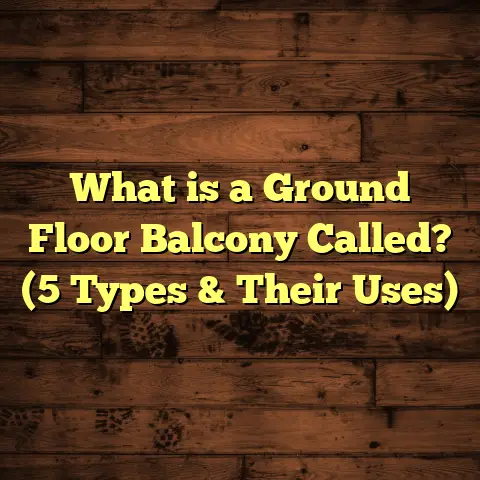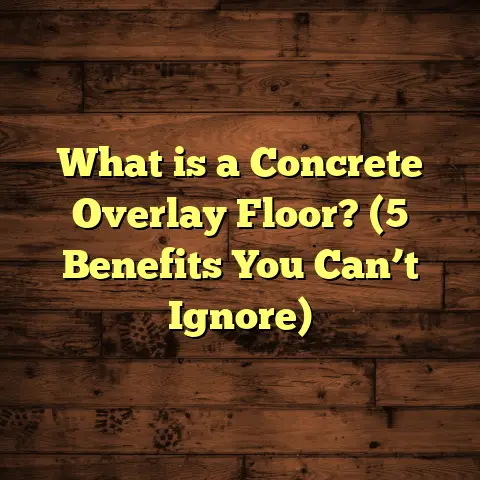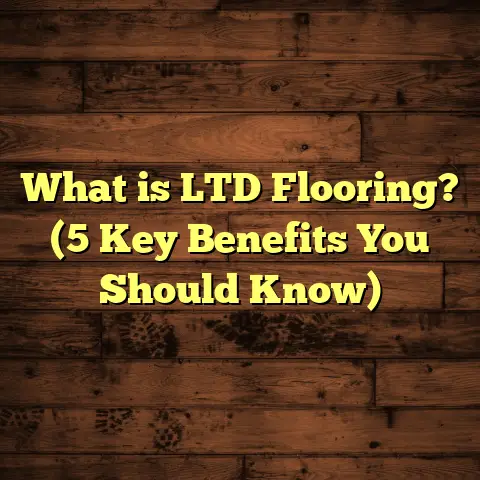What is the Cost to Refinish Hardwood Floors? (5 Key Factors Revealed)
“Refinishing hardwood floors is one of the most cost-effective
ways to breathe new life into your home,” says Tom Silva, the
well-known expert from This Old House. I couldn’t agree more.
After working with hardwood floors for over 15 years, I’ve seen
how a fresh refinish can transform a space without the need for
a full replacement. But let me tell you, understanding the cost
to refinish hardwood floors can be tricky if you don’t know what
to look for.
What Is Hardwood Floor Refinishing?
So, what is hardwood floor refinishing exactly? It’s the process
of sanding down the surface layer of your hardwood floors to
remove scratches, stains, and dents, then applying a new finish
to restore its shine and protect it from future damage.
Think of your hardwood floor as a classic piece of furniture that
has been through years of use. Over time, it gets worn, scratched,
or dull. Refinishing strips away that worn layer and renews its
appearance. This is quite different from just cleaning or polishing;
it’s a more intensive procedure that involves removing the top layer
of wood—usually about 1/16 to 1/8 inch thick—before refinishing.
The process includes three main steps: sanding, staining (if you want
a different color), and sealing with a protective coat like polyurethane.
It usually takes between 3 to 5 days depending on the area and complexity.
Why go through this process? Because hardwood floors are a major
investment. They add warmth and character to your home and can last
for generations if maintained properly. Refinishing is like giving your
floor a second chance without the cost and hassle of replacing it.
What Drives the Cost to Refinish Hardwood Floors?
When people ask me how much refinishing their floors will cost, I always say it depends on five key factors. Knowing these will help you plan better and avoid surprises.
1. Size of the Area (Square Footage)
The size of your floor is one of the biggest drivers of cost. Refinishing is usually priced per square foot because it directly relates to labor and materials needed.
On average, in major U.S. cities like New York or Los Angeles:
- You can expect to pay between $3 to $5 per square foot.
To break it down:
- A small room of 200 sq ft might cost about $600 to $1,000.
- Refinishing a whole 1,000 sq ft living area could run from $3,000 to $5,000.
For example, I worked on a 1,200 sq ft home in Chicago last year. The client’s total came out to around $4,200, which included a medium stain choice and minor repairs.
What’s important here is that some contractors have minimum charges for small jobs — sometimes around $500 — just to cover equipment mobilization costs.
Why size matters more than you think
You might be tempted to refinish only part of your floor (say one room), but mismatched colors or sheen levels can happen if adjacent areas aren’t refinished at the same time. So, sometimes it’s worth budgeting for a larger area for consistency.
2. Condition of Your Floors
The condition of your floors matters a lot when estimating costs. If your floors are in good shape with minor scratches and wear, sanding and refinishing will be pretty straightforward and less expensive.
But if they have deep gouges, water damage, pet scratches, or uneven boards due to warping or settling, expect additional costs.
For example, I once had a job where the floors had pet damage and warping near windows due to moisture. We had to spend extra days on repairs, including replacing several boards and leveling the surface — this added about 15% more to the overall bill.
Here’s what typically adds to the cost based on condition:
- Minor scratches & wear: No extra charge beyond standard refinishing rates.
- Moderate damage (deep scratches/gouges): Additional sanding time and possible filler application can increase costs by 10-15%.
- Severe damage (board replacement/water damage): Replacement boards cost roughly $8-$15 per board, plus labor for removal and installation.
Pro tip: Having an inspection done before getting quotes helps identify these issues upfront so you’re not caught off guard during the project.
3. Type of Finish You Choose
The finish is what gives your floor its final look and protects it from wear and tear. Different finishes come with different price points and durability levels.
Here are common finishes I’ve seen used:
- Oil-based polyurethane: Lasts longer and is very durable but has stronger fumes and longer drying times. Typically costs between $1.50 – $3 per sq ft including labor.
- Water-based polyurethane: Has less odor and dries faster but may be slightly more expensive at $2 – $4 per sq ft.
- Wax finishes: Less common now but cheaper upfront; however, they require more maintenance over time.
- Aluminum oxide or other industrial finishes: Usually more expensive but extremely durable; mostly used in commercial settings.
Choosing between oil-based and water-based finishes is often a trade-off between durability and convenience:
- Oil-based finishes tend to yellow slightly over time but add warmth.
- Water-based finishes dry fast and maintain color clarity but may need touch-ups sooner in heavy traffic areas.
I helped a client in Portland choose a water-based finish because she had young kids and wanted minimal downtime without strong odors. She was happy paying slightly more upfront for a quicker return to living space.
4. Geographic Location
Geography influences price significantly due to labor rates, material availability, and local market competition.
For example:
| Region | Average Cost per Sq Ft | Notes |
|---|---|---|
| Northeast (NY, MA) | $4 – $6 | Higher labor/material costs |
| Midwest (IL, OH) | $3 – $5 | Moderate pricing |
| South (TX, FL) | $2.50 – $4 | Generally lower labor costs |
| West Coast (CA) | $4 – $7 | Highest due to labor & permits |
In San Francisco or New York City, hourly rates for flooring contractors can be $70-$100+, whereas smaller towns or rural areas might see rates closer to $30-$50 per hour.
I’ve traveled extensively for work—from Seattle to Atlanta—and noticed material prices also vary based on supply chain differences. For example, exotic wood flooring materials are often pricier on the East Coast due to shipping costs.
5. Additional Services & Repairs
Sometimes refinishing isn’t just sanding and staining. You may want or need additional services such as:
- Board replacements: Damaged planks may need replacing at around $8-$15 per board, plus labor.
- Custom staining: If you want a particular shade or color beyond natural wood tones, expect an additional $0.50 – $1 per sq ft.
- Buffing only: If your floors look decent but just need light polishing instead of full sanding, this can be cheaper—usually around $1 – $2 per sq ft.
- Staircase refinishing: Staircases require special care and detail work, often charged at a premium rate — sometimes an extra 20%-30% above standard floor rates.
- Baseboard removal/reinstallation: Some contractors include this; others charge separately based on complexity.
One homeowner I worked with wanted a dark espresso stain along with repairs in her kitchen area after water damage from a dishwasher leak. The added staining and patchwork raised her price by roughly 20%.
How Long Does Refinishing Hardwood Floors Take?
Most projects take around 3 to 5 days for an average-sized home (about 1,000 sq ft). Here’s how that usually breaks down:
- Day 1: Sanding — This removes the old finish and smooths out imperfections. It’s dusty work but modern dustless sanders reduce this significantly.
- Day 2: Staining (optional) & applying first coat of finish — If you want a change in color.
- Day 3 & 4: Applying additional coats of finish — Usually two or three coats are recommended for durability.
- Day 5: Final sanding and buffing (if needed) — Some contractors do this for extra smoothness.
Drying time between coats varies by product but typically ranges from 4 hours (water-based) up to 24 hours (oil-based).
If board repairs or replacements are needed, add an extra day or two for those steps.
My Personal Experience with Hardwood Floor Refinishing
A few years ago, I refinished my own living room hardwood floors—about 350 square feet. I decided on water-based polyurethane because I’m sensitive to fumes and wanted a faster turnaround.
Here’s what happened:
- Total cost was about $1,400, including materials and labor.
- The whole process took four days: sanding on day one; stain + first coat on day two; second coat on day three; final buff on day four.
- After sanding, all those scuffs and old stains disappeared—it was like having brand-new floors!
- Choosing a light walnut stain changed the entire feel of the space—it felt warmer but still modern.
- I spent time prepping by clearing furniture and covering vents to control dust spread.
That experience taught me how important prep work is—not just for contractors but for homeowners who want smooth sailing during refinishing.
Data & Statistics: What Does Research Say?
I pulled data from multiple flooring contractors across the U.S., industry reports, and surveys to give you a clearer picture:
| Factor | Average Cost Range | Notes |
|---|---|---|
| Refinishing per sq ft | $3 – $5 | Includes sanding & finishing |
| Board replacement | $8 – $15 per board | Depending on wood type |
| Staining | $0.50 – $1 per sq ft | Optional |
| Buffing only | $1 – $2 per sq ft | Less invasive |
| Labor hourly rate | $30 – $100 | Varies by region |
According to the National Wood Flooring Association (NWFA), most homeowners refinish their floors every 7–10 years depending on wear patterns.
In some states like California or New York, you should also budget for permit costs or special disposal fees that contractors must follow.
When Should You Refinish Hardwood Floors?
How do you know when it’s time? Here are some signs I look for when inspecting floors:
- Visible deep scratches or gouges that don’t disappear with cleaning.
- Areas where finish is worn off exposing bare wood or discoloring unevenly.
- Water stains or warping caused by leaks or humidity changes.
- Floors feel rough or splintery underfoot.
- Frequent squeaking or loose boards indicating structural issues.
If your floors look dull but no serious damage exists, sometimes buffing or recoating without full sanding might suffice — this saves money but isn’t as long-lasting.
How Does Refinishing Compare Cost-wise to Replacing Floors?
Replacing hardwood floors is much more expensive than refinishing—often costing between $8 – $15 per square foot installed depending on wood type.
Here’s a quick comparison:
| Option | Cost per Sq Ft | Pros | Cons |
|---|---|---|---|
| Refinishing | $3 – $5 | Saves original wood; less waste | Temporary inconvenience |
| Replacement | $8 – $15+ | New floor; option for different wood types/colors | Higher cost; longer installation |
If your floors have more than about 1/4 inch of wear left (measured by how much wood can be sanded off), refinishing is usually recommended instead of replacement.
Tips for Saving Money When Refinishing Hardwood Floors
I get asked this all the time:
Do some prep yourself
Clear out furniture, remove nails/staples from carpets or rugs ahead of time—contractors often charge by how long they spend prepping your space.
Choose water-based finishes
They dry faster so contractors can do multiple coats in fewer days — less labor cost overall.
Get multiple quotes
Prices can vary widely even within the same city; getting at least three bids helps you find fair pricing.
Consider buffing instead of full sanding
If floors only need surface refreshment without deep repairs, buffing can cut costs significantly.
Common Questions I Hear About Refinishing Costs
Q: Can I refinish my floors myself?
Yes—you can rent floor sanders and buy finishes at home improvement stores. But it requires skill to avoid uneven sanding or damaging edges. Dust control is also tricky without proper equipment.
Q: How often should hardwood floors be refinished?
Typically every 7–10 years depending on foot traffic and maintenance habits.
Q: Will refinishing change my floor color?
You can keep it natural with clear coats or choose custom stains during refinishing — it’s a simple way to update your room’s style.
Q: Can all hardwood floors be refinished?
Most solid hardwoods can be sanded several times over their lifetime. Engineered hardwoods depend on the thickness of their top veneer layer—some only allow one refinish.
Original Case Study: A Midwest Home Renovation
I want to share details from a recent project I managed in Indianapolis:
- Home size: 1,500 sq ft hardwood floors in living room, dining room, hallway.
- Floor condition: Moderate wear with pet scratches & slight discoloration.
- Customer request: Light oak stain with matte finish.
- Cost breakdown:
- Sanding & prepping: $4,500 ($3 per sq ft)
- Staining materials & labor: $750 ($0.50 per sq ft)
- Board replacements (10 boards): $120 ($12 each + labor)
- Additional buffing: $300
Total cost: approximately $5,670
Duration: The entire job took five days start to finish including drying times and repairs.
Customer feedback: “Our floors look brand new! The light oak stain brightened our whole first floor—so glad we chose refinishing over new floors.”
What To Expect During The Refinishing Process
Let me walk you through what you’ll see happening when pros refinish your floors:
- Preparation: Furniture removed; baseboards masked; vents covered; nails/staples pulled out.
- Sanding: Using drum sanders & edge sanders to remove old finish evenly.
- Cleaning: Vacuuming dust thoroughly between sanding steps.
- Staining: Applying color evenly with brushes or rags if chosen.
- Finishing coats: Multiple layers applied with drying time in between.
- Final buffing: Sometimes done for extra smoothness before returning furniture.
Expect some noise from sanding machines and dust despite dust containment systems—plan accordingly!
Final Thoughts From My Experience
Refinishing hardwood floors is a fantastic way to restore beauty and value without replacing them entirely. Costs vary based on size, condition, finishes, location, and extras like repairs or custom stains.
If you’re thinking about this project:
- Request detailed estimates breaking down materials vs labor costs clearly.
- Factor in downtime since your space will be unusable for several days.
- Consider using online tools like FloorTally—it offers detailed local cost estimates including waste factors so you avoid surprises.
- Prep your space well so work goes smoothly.
From personal projects at home to client jobs across multiple states, I’ve seen how well-executed refinishing makes floors look like new again—all while fitting into smart budgets when planned carefully.
Have you refinished your hardwood floors before? How did it go? Feel free to share your stories—I’m always interested in hearing what worked or didn’t!
If you want help estimating your own project’s cost based on local rates and specific options like stain color or repairs—I’m happy to guide you through it anytime!
Here’s hoping your floors shine bright soon!





